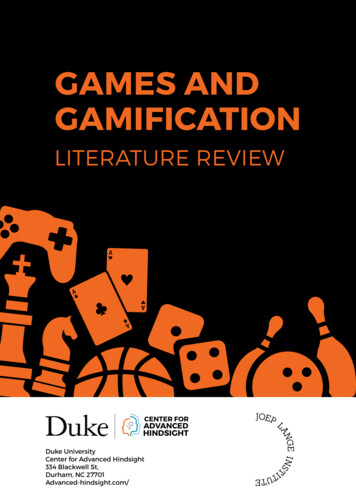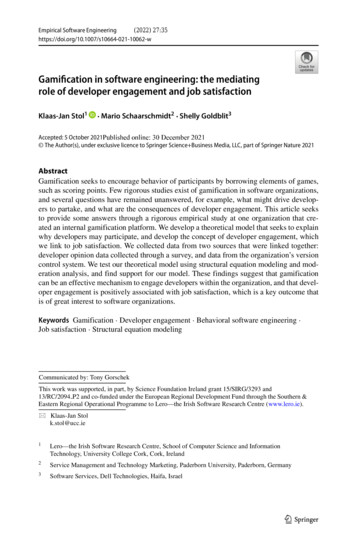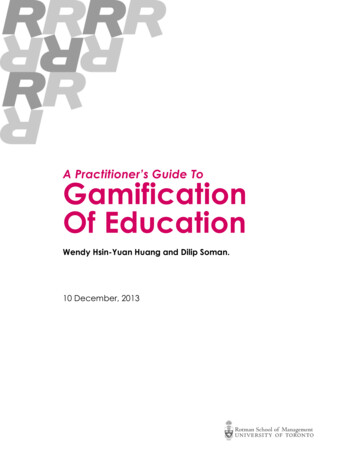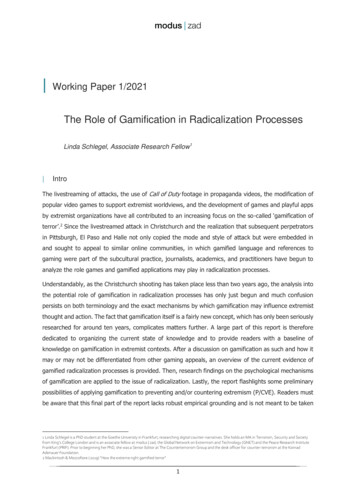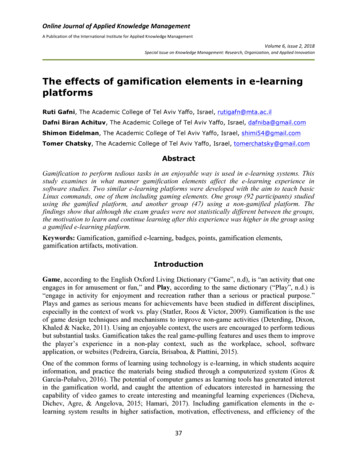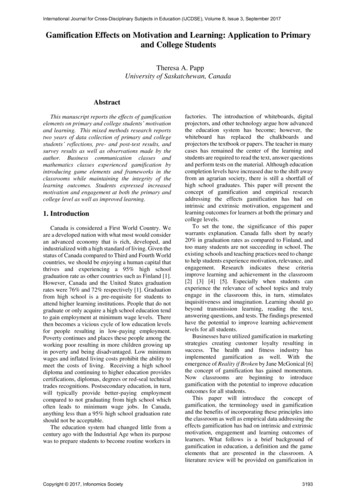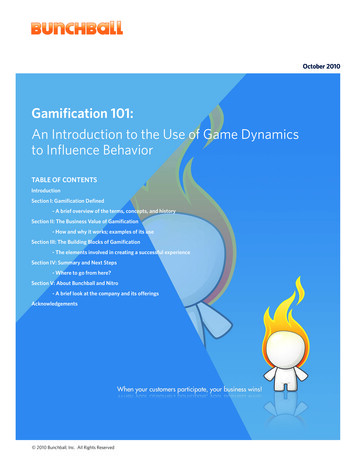
Transcription
Gamification: Experts expect‘game layers’ to expand in the future,with positive and negative resultsTech stakeholders and analysts generally believe the use of game mechanics,feedback loops, and rewards will become more embedded in daily life by2020, but they are split about how widely the trend will extend. Some say themove to implement more game elements in networked communications willbe mostly positive, aiding education, health, business, and training. Somewarn it can take the form of invisible, insidious behavioral manipulation.Janna Quitney Anderson, Elon UniversityLee Rainie, Pew Research Center’s Internet & American Life ProjectMay 18, 2012Pew Research Center’s Internet & American Life ProjectAn initiative of the Pew Research Center1615 L St., NW – Suite 700Washington, D.C. 20036202-419-4500 pewinternet.orgThis publication is part of a Pew Research Center series that captures people’s expectationsfor the future of the Internet, in the process presenting a snapshot of current attitudes. Findout more at: ternet.aspx andhttp://www.imaginingtheinternet.org.
OverviewThe word “gamification” has emerged in recent years as a way to describe interactive onlinedesign that plays on people’s competitive instincts and often incorporates the use of rewards todrive action—these include virtual rewards such as points, payments, badges, discounts, and“free” gifts; and status indicators such as friend counts, retweets, leader boards, achievementdata, progress bars, and the ability to “level up.”While some people dismiss gamification as a fad, neuroscientists are discovering more and moreabout the ways in which humans react to such interactive design elements. They say suchelements can cause feel-good chemical reactions, alter human responses to stimuli—increasingreaction times, for instance—and in certain situations can improve learning, participation, andmotivation.Technology consultancy Gartner has projected 50% of corporate innovation will be “gamified”by 2015. Another consulting firm, Deloitte, cited gamification as one of its Top 10 TechnologyTrends for 2012, predicting: “Serious gaming simulations and game mechanics such asleaderboards, achievements, and skill-based learning are becoming embedded in day-to-daybusiness processes, driving adoption, performance, and engagement.” Elements of gamemechanics are being employed nowadays in training, marketing, education, and wellnessinitiatives.Gameplay has long been a popular pursuit, from the simplest moves of Go, first played in China3,000 years ago, to the massively multiplayer online games of today. Digital games generated 25 billion in sales in 2010, and their popularity is considered to be a driver of the adoption ofelements of gamification in many Internet pursuits.Another primary driver is the rapid uptake of social networks, now used by 70% of AmericanInternet users, where reward and status elements are embedded in implicit and explicit forms inpeople’s interactions in their engagement in online communities. Game elements andcompetition are interspersed throughout the platforms that have made social networks likeFacebook and Twitter popular.Marketers, businesses, and other organizations have come to depend upon the competitivemetrics they derive from analysis and implementation of social networks to measure and driveconsumer behavior.Gamification is not, however, just about status, community building, and marketing. Game-likeapproaches to education and problem-solving are rolling out in new ways. To cite oneprominent example, researchers at the University of Washington made headlines in 2011 withtheir game Foldit. It generated a crowd-sourced discovery of the mystery of how a key proteinmay help cure HIV. The game drew 46,000 participants whose gameplay took just 10 days tosolve a problem scientists had been working on for 15 years. Non-digital and digital real-worldgames based on scenarios and problem-solving have been around for a while, but it wasn’t untilrecent years that the label “serious game” was applied to this type of activity.Some scholars and educators, too, have become interested in harnessing the potential ofgaming mechanics and sensibilities as tools for advancing learning. A “serious gaming”movement has arisen to apply gaming techniques to such realms as military and corporate andfirst-responder training programs, civilization and environmental ecology simulations, K-12
educational programs on subjects like math and history and the sciences, news events andpublic policy campaigns, problem-solving strategies in the natural sciences, and even physicalexercise programs.Will the use of gamification, game mechanics, feedback loops, and rewards to spur interactionand boost engagement, buy-in, loyalty, fun, and/or learning continue to gain ground and beimplemented in many new ways in people’s digital lives between now and 2020?A highly engaged, diverse set of respondents were asked by the Pew Research Center’s Internet& American Life Project and Elon University’s Imagining the Internet Center to answer thisquestion in an online, opt-in survey. Some 1,021 technology stakeholders and critics respondedin a more or less split verdict. Some 53% said yes that gamification will be widespread, but anumber of them qualified this by saying the evolving adoption of gamification will continue tohave some limits. Some 42% chose a more modest scenario that predicted gamification will notevolve to be a larger trend except in specific realms. Here are the details:42% agreed with the statement:By 2020, gamification (the use of game mechanics, feedback loops, and rewards to spurinteraction and boost engagement, loyalty, fun and/or learning) will not be implementedin most everyday digital activities for most people. While game use and game-likestructures will remain an important segment of the communications scene and will havebeen adopted in new ways, the gamification of other aspects of communications will notreally have advanced much beyond being an interesting development implementedoccasionally by some segments of the population in some circumstances.53% agreed with the opposite statement, which posited:By 2020, there will have been significant advances in the adoption and use ofgamification. It will be making waves on the communications scene and will have beenimplemented in many new ways for education, health, work, and other aspects ofhuman connection and it will play a role in the everyday activities of many of the peoplewho are actively using communications networks in their daily lives.Respondents were asked to select the one statement of the two scenarios above with whichthey mostly agreed; the question was framed this way in order to encourage a spirited anddeeply considered written elaboration about the potential future.Here is a sampling of their predictions and arguments:Playing beats working. So, if the enjoyment and challenge of playing can be embedded inlearning, work, and commerce then gamification will take off. It will help if the personalrewards of the social side of game playing spread to other realms.One of the most affirming arguments came from an anonymous survey respondent:“Gaming functionality will continue to grow and be used in more and more facets of our lives.People will receive training on the job, be exposed through education and developmentprograms, have the ability to learn about areas that are important to them using this technologyand social strategy. It will allow people to understand complex topics faster and with more
nuances, and make the learning process more anticipated and less to be feared or avoided. Newideas will spread faster as the ability to educate more people becomes easier and quicker.”Others made the case this way: “The development of ‘serious games’ applied productively to a wide scope of humanactivities will accelerate simply because playing is more fun than working.” – MikeLiebhold, senior researcher and distinguished fellow at The Institute for the Future “Playbor (play plus labor) and weisure (work plus leisure) will be ubiquitous.” – P.J. Rey,managing editor of the Cyborgology blog “Gamification may be the most important social and commercial development of thenext fifty years. Commercially, we may be seeing the end of the marketing orientation,possibly marking the beginning of the ‘game orientation.’ This will touch all aspects ofthe organization as it is applied to sales, production, management, and other areas ofcommercial practice. Socially, gamified technology will evolve and humanize many ofthe artificial interactions we currently endure—check-in’s, like’s, shares, and their kinwill all ‘just work’ and drive new waves of innovation in our technology.” – Ross Rader,general manager at Hover and board member of the Canadian Internet RegistrationAuthority “People will increasingly expect game elements in a wide range of activities. Gamedevelopment tools will enable most people to gamify many aspects of life and work, indigital, physical, and blended environments.” – Cathy Cavanaugh, associate professor ofeducational technology, University of Florida “Game mechanics and leveling up have been used in the military, the orchestra, schools,and in general professions since the beginning of human civilization . The idea of gamemechanics will simply blend into the idea of experience design or motivation design andmarketing, making it easier for users to stick with a new experience.”— Amber Case,sociologist and popular speaker, and CEO of Geoloqi “As more and more ‘intelligence’ is injected into a ‘gamed’ response, it gains more andmore ability to impact whatever it is applied to With the sophistication that can beinserted into interactive responses, game-like approaches will be applied across anincreasingly wide sphere of human endeavors.” – Charles Perrottet, partner at theFutures Strategy Group “Movements like the Quantified Self will make everything we do into our own game ofself-improvement, learning, and real-time advances uniquely crafted to how we learnand what we want to learn or become proficient at. People’s ability to advance in anyfield will be self-controlled, automatically recorded, and unique skill sets will emerge asneeded.” – Alan Bachers, director of the Neurofeedback Foundation “The US military has been one of the largest developers and users of videogaming andsimulation for training. Companies have developed more than just flight simulators forlearning. The Disney’s, EAS’s, and others are, or will be, seeing more commercial
opportunity to create better products for multiple subjects at multiple grade levels. Tome, it is just a matter of time before public schools purchase and partner to use thesetools, or get replaced in a vouchered world brought about by these companies wantinginto the market and being big enough to counteract the political power of school unionsand the boards they control.” —Ed Lyell, professor at Adams State CollegeGames can be compelling and that can easily lead to behavioral manipulation. “It’s a modern-day form of manipulation. And like all cognitive manipulation, it can helppeople and it can hurt people. And we will see both.”– danah boyd, researcher,Microsoft and Harvard’s Berkman Center “Game mechanics will indeed be part of the lingua franca, but it will be seen as what itis—another tool of commerce trying a little too hard to wring personalized interactionsout of mass behavior.” – Mack Reed, principal at Factoid Labs “Companies should take responsibility for the tremendous power they wield in society. Ifear they won’t, but I hope they do. Then of course, you can also say I hopeconsumers—people experiencing gamification on the ground—are also aware (as bestthey can be) of the games they are engaging with, what are their purposes, whodeveloped them, why, and so on. We’ve all got to be very critical when fun can masktrouble.” – David Kirschner, research assistant at Nanyang Technological University,Singapore “I’m all for feedback loops in our complex world. Emergence is how everything works.But for some reason, I’m resisting their explicit disruptive role in education and health.There are too many entrenched reasons (some of them good reasons) not to run thingsthis way. If everything was a game, no one would have a reason to invent; any metriccorrupts, as people shape their behavior to ensure that they come out on top. Therehave to be other routes to excellence in work, health, and education; there have to beways to explore, invent, create, and avoid—it can’t be that we’ll be adding up points forevery salient element of our lives . Excuse me, now, while I check whether I’ve beenmentioned on Twitter.” – Susan Crawford, founder of OneWebDay and former ObamaWhite House technology policy expertThe real energy in social innovation will come in software that privileges cooperation. “Gamification has little use in cooperation, and that is the area of social software that isleast realized at this time, and which I predict will be the highest-growth area in thefuture.” – Stowe Boyd, consultant and authorThe infatuation with gamification is today’s fad and will fade. “For all of the reasons that critics of game theory have identified over the yearsregarding its inability to capture the full range of human motivations, perceptions,cognitions, and practices, I believe there will be efforts to gamify much of what we do,but that much of that will just come and go as fads.” – Sandra Braman, professor at theUniversity of Wisconsin-Milwaukee and an expert on information policy.The term “gamification” itself could use an upgrade.
“By 2020, anyone who ever used the term ‘gamification’ will be embarrassed to admitit.” – Alex Halavais, associate professor, Quinnipiac University “Like ‘Web 2.0’, the term ‘gamification’ will fade away as the enormity of its successsweeps across the globe.” – Bryan Alexander, senior fellow at the National Institute forTechnology in Liberal Education “Gamification is a horrible made-up word. Just say games. Just say gaming interfaces.Just say game-design thinking.” – Vicki Suter, director of the California Virtual CampusFurther points they made: While it has some drawbacks, gamification offers advantages in encouraging behaviorsand generating measureable feedback. Game-style engagement can bring an element of enjoyment to otherwise dull orchallenging tasks, thus it will become a vital aspect of training, personal health,business, and education. People are often not aware of corporations’ and governments’ surreptitious use ofgamification data and patterns to gain intelligence. Game-like approaches are generally a pandering to people’s already overmet desire tobe entertained. Some people could be “lost” to game-style approaches, causing an overall loss inproductivity and other negative outcomes. It is not wise to make everything into a competition or to force people into a situation inwhich they are expected to have to collect points for every human move.Barry Chudakov, principal at Metalife Consulting and a visiting research fellow in the McLuhanProgram in Culture and Technology at the University of Toronto, shared a comprehensive view:“Play, it seems, may not only be an end in itself, it may be a better way to view and understandthe world. The brilliant game designer and thinker Jane McGonigal has been saying for a fewyears, ‘Reality is broken. Why aren’t game designers trying to fix it?’ Recently gamersdeciphered the structure of an enzyme of an AIDS-like virus that had thwarted scientists for adecade. We will soon realize that games generate alternative realities. Because we view them asfictional worlds that are made-up, invented to entertain, we miss their astonishing utility. By2020 we will see that these games and virtual worlds provide alternative ways of seeing andthinking, which is the essence of innovation. Games are like the apple falling in front ofNewton’s eyes. Seeing the apple fall, Newton understood something else, namely gravity. Ourview of gaming may be a legacy of the live-to-work ethos of the Industrial Revolution; this viewmay keep us from seeing the powerful uses of gaming. By 2020 we will realize that gaming’sready-made (albeit carefully crafted) metalife is one of the best ways ever devised to see,understand, and improve upon reality.”Another comprehensive insight came from futurist John Smart, founder of the AccelerationStudies Foundation. “By 2020, gamification will have made more advances in entertainment and
more inroads in education and mass consumption,” he predicted, “but it will remain niche evenfor most retail businesses, as well as for health, work, self-help, personal productivity, selfquantification, and other domains. People want to be increasingly entertained, and TheEntertainment Economy and The Experience Economy are two good books describing how thebest businesses will continue to drive us in that direction. But we simply don’t have the artificialintelligence necessary to build really good versions of this yet, and educational software remainspitifully poor at creating games that improve, rather than distract from learning. By 2030, oncewe have a real valuecosm, and our artificial intelligence agents (our cyber twins) have goodmodels of the values, history, and learning goals of their biological twins (us), we’ll have anenvironment where gamification could move significantly beyond entertainment. Until then,notwithstanding great visionary works like Jane McGonigal’s Reality is Broken, don’t expectgamification to move us much beyond increasingly better entertainment games, and moreserious games titles. Serious games will continue to remain mostly in the long tail rather thanthe fat head of the game market until serious artificial intelligence emerges.”Survey Method:‘Tension pairs’ were designed to provoke detailed elaborationsThis material was gathered in the fifth “Future of the Internet” survey conducted by the PewResearch Center’s Internet & American Life Project and Elon University’s Imagining the InternetCenter. The surveys are conducted through an online questionnaire sent to selected experts who areencouraged to share the link with informed friends, thus also involving the highly engaged Internetpublic. The surveys present potential-future scenarios to which respondents react with theirexpectations based on current knowledge and attitudes. You can view detailed results from the2004, 2006, 2008 and 2010 surveys here: ernet.aspx and s/default.xhtml. Expandedresults are also published in the “Future of the Internet” book series published by Cambria Press.The surveys are conducted to help accurately identify current attitudes about the potential future fornetworked communications and are not meant to imply any type of future forecast.Respondents to the Future of the Internet V survey, fielded from August 28 to Oct. 31, 2011, wereasked to consider the future of the Internet-connected world between now and 2020. They wereasked to assess eight different “tension pairs” – each pair offering two different 2020 scenarios withthe same overall theme and opposite outcomes – and they were asked to select the one most likelychoice of two statements. The tension pairs and their alternative outcomes were constructed toreflect previous statements about the likely evolution of the Internet. They were reviewed andedited by the Pew Internet Advisory Board. Results are being released in eight separate reports overthe course of 2012. This is the fourth of the reports.About the survey and the participantsPlease note that this survey is primarily aimed at eliciting focused observations on the likely impactand influence of the Internet – not on the respondents’ choices from the pairs of predictivestatements. Many times when respondents “voted” for one scenario over another, they respondedin their elaboration that both outcomes are likely to a degree or that an outcome not offered wouldbe their true choice. Survey participants were informed that “it is likely you will struggle with most or
all of the choices and some may be impossible to decide; we hope that will inspire you to writeresponses that will explain your answer and illuminate important issues.”Experts were located in three ways. First, several thousand were identified in an extensivecanvassing of scholarly, government, and business documents from the period 1990-1995 to seewho had ventured predictions about the future impact of the Internet. Second, several hundred ofthem have participated in the first four surveys conducted by Pew Internet and Elon University, andthey were contacted again for this survey. Third, expert participants were selected due to theirpositions as stakeholders in the development of the Internet. The experts were invited to encouragepeople they know to also participate. Participants were allowed to remain anonymous; 57% sharedtheir name in response to at least one question.Here are some of the respondents: danah boyd, Clay Shirky, Bob Frankston, Glenn Edens, CharlieFirestone, Amber Case, Paul Jones, Dave Crocker, Susan Crawford, Jonathan Grudin, Danny Sullivan,Patrick Tucker, Rob Atkinson, Raimundo Beca, Hal Varian, Richard Forno, Jeff Jarvis, DavidWeinberger, Geoff Livingstone, Stowe Boyd, Link Hoewing, Christian Huitema, Steve Jones, RebeccaMacKinnon, Mike Leibhold, Sandra Braman, Ian Peter, Mack Reed, Seth Finkelstein, Jim Warren,Tiffany Shlain, Robert Cannon, and Bill Woodcock.The respondents’ remarks reflect their personal positions on the issues and are not the positions oftheir employers. Their leadership roles in key organizations, however, help identify them as experts.Following is a representative list of some of the institutions at which respondents work or haveaffiliations or previous work experience: Google, the World Bank, Microsoft, Cisco Systems, Yahoo!,Intel, IBM, Hewlett-Packard, Ericsson Research, Nokia, O’Reilly Media, Verizon Communications,Institute for the Future, Federal Communications Commission, British OfCom, World Wide WebConsortium, National Geographic Society, Benton Foundation, Linux Foundation, Association ofInternet Researchers, Internet2, Internet Society, Institute for the Future, Santa Fe Institute, YankeeGroup, Harvard University, MIT, Yale University, Georgetown University, Oxford Internet Institute,Princeton University, Carnegie-Mellon University, University of Pennsylvania, University of CaliforniaBerkeley, Columbia University, University of Southern California, Cornell University, University ofNorth Carolina, Purdue University, Duke University, Syracuse University, New York University,Northwestern University, Ohio University, Georgia Institute of Technology, Florida State University,University of Kentucky, University of Texas, University of Maryland, University of Kansas, Universityof Illinois, and Boston College.While many respondents are at the pinnacle of Internet leadership, some of the survey respondentsare “working in the trenches” of building the Web. Most of the people in this latter segment ofresponders came to the survey by invitation because they are on the email list of the Pew Internet &American Life Project, they responded to notices about the survey on social media sites, or theywere invited by the expert invitees. They are not necessarily opinion leaders for their industries orwell-known futurists, but it is striking how much their views are distributed in ways that parallelthose who are celebrated in the technology field.While a wide range of opinions from experts, organizations, and interested institutions was sought,this survey should not be taken as a representative canvassing of Internet experts. By design, thissurvey was an “opt in,” self-selecting effort. That process does not yield a random, representativesample. The quantitative results are based on a non-random online sample of 1,021 Internet expertsand other Internet users, recruited by email invitation, Twitter, Google , or Facebook. Since the data
are based on a non-random sample, a margin of error cannot be computed, and results are notprojectable to any population other than the respondents in this sample.When asked about their primary workplace, 40% of the survey participants identifiedthemselves as a research scientist or as employed by a college or university; 12% said they wereemployed by a company whose focus is on information technology; 11% said they work at anon-profit organization; 8% said they work at a consulting business, 10% said they work at acompany that uses information technology extensively; 5%noted they work for a governmentagency; 2% said they work for a publication or media company.When asked about their “primary area of Internet interest,” 15% identified themselves asresearch scientists; 11% said they were futurists or consultants; 11% said they wereentrepreneurs or business leaders; 11% as authors, editors or journalists; 10% as technologydevelopers or administrators; 6% as advocates or activist users; 5% as legislators, politicians orlawyers; 3% as pioneers or originators; and 28% specified their primary area of interest as“other.”
Main Findings: Getting into the gamification?TOTAL%RESPONSESTension pair on future of gamification42By 2020, gamification (the use of game mechanics, feedbackloops, and rewards to spur interaction and boost engagement,loyalty, fun and/or learning) will not be implemented in mosteveryday digital activities for most people. While game use andgame-like structures will remain an important segment of thecommunications scene and will have been adopted in newways, the gamification of other aspects of communications willnot really have advanced much beyond being an interestingdevelopment implemented occasionally by some segments ofthe population in some circumstances.53By 2020, there will have been significant advances in theadoption and use of gamification. It will be making waves onthe communications scene and will have been implemented inmany new ways for education, health, work, and other aspectsof human connection and it will play a role in the everydayactivities of many of the people who are actively usingcommunications networks in their daily lives.5Did not respondPLEASE ELABORATE: Explain your choice and share your view of gamification andimplications for the future. What new approaches to information sharing do you anticipate willbe finding their footing by 2020? What are the positives, negatives, and shades of grey in thelikely future you anticipate? (If you want your answer cited to you, please begin yourelaboration by typing your name and professional identity. Otherwise your comment will beanonymous.)Note: The survey results are based on a non-random online sample of 1,021 Internet experts and other Internet users, recruitedvia email invitation, conference invitation, or link shared on Twitter, Google Plus or Facebook from the Pew Research Center’sInternet & American Life Project and Elon University. Since the data are based on a non-random sample, a margin of error cannotbe computed, and the results are not projectable to any population other than the people participating in this sample. The“predictive” scenarios used in this tension pair were composed based on current popular speculation. They were created to elicitthoughtful responses to commonly found speculative futures thinking on this topic in 2011; this is not a formal forecast.Respondents’ thoughtsThere was a split verdict among experts about the scope and power of the gamification trend.Some 53% of the respondents to this survey said the use of game mechanics, feedback loops,and rewards to spur interaction and boost engagement, loyalty, fun, and/or learning willcontinue to gain ground between now and 2020. A number of survey participants qualified thisby saying the adoption of gamification will continue to have some limits. Moreover, 42% saidgenerally the trend will not advance except in specific realms. One anonymous surveyrespondent spoke for many, writing, “I expect more use of gaming-inspired ideas where thatmakes sense, but I don’t expect it to become a pervasive feature of many or most everydayactivities for people using communications networks.”
Overall, a modest majority of the top tech experts participating in this survey believe gameelements in some form will continue to play a role of gathering importance in the everydayactivities of many of the people who are actively using communications networks. “Thedevelopment of ‘serious games’ applied productively to a wide scope of human activities willaccelerate simply because playing is more fun than working,” observed Mike Liebhold, seniorresearcher and distinguished fellow at The Institute for the Future.Survey respondents framed their conception of “gamification” in highly varied ways, ranging—ingame-name terms—from massively multiplayer online games such as Star Wars: The OldRepublic to World of Warcraft (a “virtual world”) to Farmville (social network-based game) toAngry Birds (popular smartphone app) to Foldit, a game that researchers used to crowdsource ascientific solution to an AIDS question, to training simulations, to the “points” (sometimes onlyin terms of social currency) one gathers for action in social interactions online, including havingthe most Twitter or Facebook connections or mentions.Some people said it’s “too soon” for highly interactive elements to enhance effectively onlineinteractions for most people while others said we’re already there and we have been for a while.One anonymous respondent wrote, “Gamification is the same thing as an ‘incentive plan’ whichwas well documented (but not invented) by Mark Twain in Tom Sawyer. Our only innovation isto use technology to loosely affiliate more and more gaming metrics, tools, and interfaces withour day-to-day a
Gamification: Experts expect ‘game layers’ to expand in the future, with positive and negative results Tech stakeholders and analysts generally believe the use of game mechanics, feedback loops, and rewards will become more embedded in daily life by 2020, but they are s
